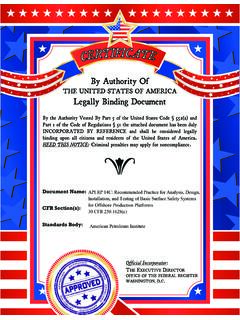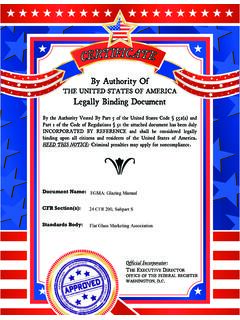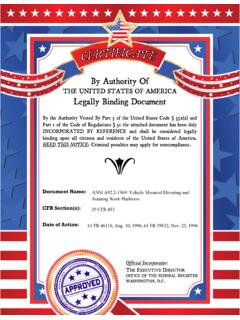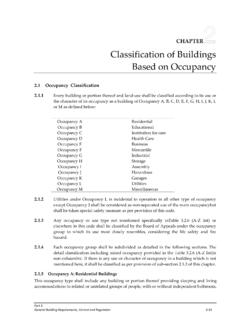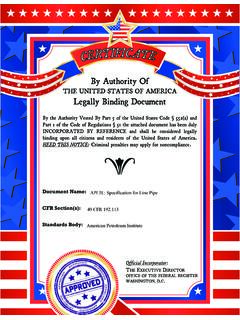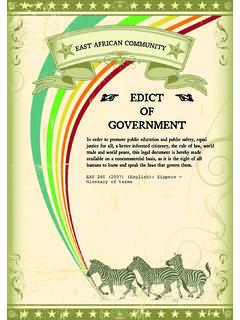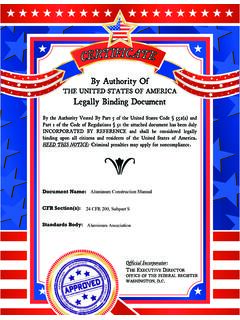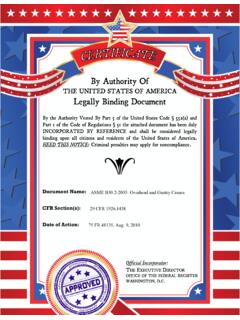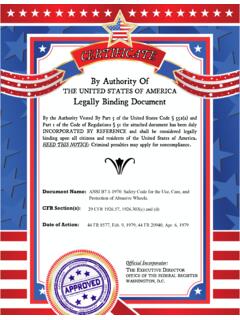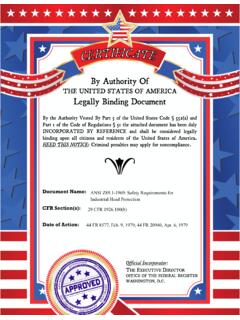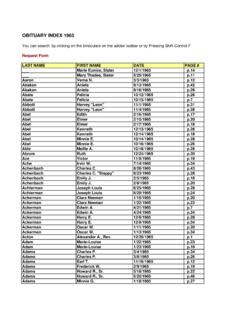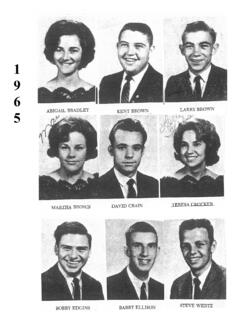Transcription of By Authority Of - Public.Resource.Org
1 By Authority OfTHE UNITED STATES OF AMERICAL egally Binding DocumentBy the Authority Vested By Part 5 of the United States Code 552(a) and Part 1 of the Code of Regulations 51 the attached document has been duly INCORPORATED BY REFERENCE and shall be considered legally binding upon all citizens and residents of the United States of America. HEED THIS NOTICE: Criminal penalties may apply for noncompliance. Official Incorporator:THE EXECUTIVE DIRECTOROFFICE OF THE FEDERAL REGISTERWASHINGTON, Name: CFR Section(s): Standards Body: eeGA P .. 1-1965 (OBSOLETE) SAFE HANDLING OF COMPRESSED GASES FIFTH EDITION COMPRESSED GAS ASSOCIATION, INC. 4221 Walney Road, 5th Floor Chantilly, VA 20151 Phone: 703-788-2700 Fax: 703-961-1831 E-mail: PAGE ii _____ -"C""O"'Mc:.:. :..R:,::E-"'S"'-SE""O"--'=G:.:..A"" :..A-!-"S""S""O""Cc:,:.IA"-'"T-'-'IO"-'- N"'-',-"INc.
2 :.;C"'. _____ CGA P-1-1965 Contents Page Introduction .. 1 2 Regulations applying to compressed gases .. 1 3 Safe handling rules for cylinders of compressed gases .. 2 General .. , .. 2 Moving cylinders .. 4 Storing cylinders .. 5 Withdrawing cylinder .. 5 Flammable gases .. 7 Poison gases .. 7 Pressurized liquid oxygen, nitrogen and argon .. 8 4 General precautions for tank cars .. 8 5 Cargo tank motor vehicles .. 10 6 Bibliography .. 10 7 References .. 11 FIFTH EDITION: 1965 COPYRIGHT 1965 BY THE COMPRESSED GAS ASSOCIATION, INCORPORATED PRINTED IN CGA P-1-1965 _____ ---"'C""O"-'-M!!..P.!..!R""ES""S""E'-"'D :..:G""A-"'S'-' !:s""s""O""C"-'IA.!..!T-'-'IO"'-N.!J.,.. !!IN-'-'C"-'. _____ PAGE 1 1 Introduction 1,1 Compressed gas containers, when constructed according to the proper Interstate Commerce Commission (ICC) Specification and maintained in accordance with ICC Regulations, may be considered safe for the pur-poses for which they are intended.
3 Accidents occurring during the transportation, handling, use and storage of these containers can almost invariably be traced to failure to follow ICC requirements or to abuse or mishan-dling of the containers. The following rules compiled by the Compressed Gas Association Inc. are primarily for the guidance of users of compressed gases in cylinders and are based upon accident prevention experience within these industries. (General precautions are also included for tank car handling and reference is made to cargo tank handling). It should not be assumed that every acceptable safety precaution is contained herein, or that abnormal or un-usual circumstances may not warrant or require further or additional procedure. The information contained in this pamphlet was obtained from sources believed to be reliable and is based upon the experience of members of the Compressed Gas Association, Inc.
4 However, by the issuance of this pamphlet the association and its members, jOintly and severally, make no guarantee of results and assume no liability in connection with the information herein contained, or for the safety suggestions herein made. 2 Regulations applying to compressed gases The transportation of compressed gases is regulated by the United States Government under the provisions of an Act of the Congress dated March 4, 1921, known as "The Transportation of Explosives Act." This Act is ad-ministered by the Interstate Commerce Commission for railway and for highway transport. The transportation of compressed gases by water comes under the jurisdiction of the United States Coast Guard. Transportation of compressed gases by air is regulated by the Federal Aviation Agency. The storage and use of compressed gases are regulated by many state or municipal authorities.
5 For regulatory purposes a compressed gas is defined by the ICC as " .. any material or mixture having in the container either an absolute pressure exceeding 40 pounds per square inch at 70 F, or an absolute pressure exceeding 104 pounds per square inch at 130 F, or both; or any liquid flammable material having a Reid vapor pressure exceeding 40 pounds per square inch absolute at 100 F." (See 700 of ICC Regulations.[1]) ICC Regulations require that compressed gases be shipped in containers manufactured to ICC specifications and maintained in accordance with ICC Regulations. In Canada, containers in which compressed gases are shipped by rail must comply with the specifications and regulations of the Board of Transport Commissioners for Canada (BTC). Container specifications require, among other things, that the metals used meet certain chemical and physical requirements and that the container pass an initial hydrostatic pressure test.
6 PAGE 2 _____ .::::C""Oc:.:.M"-P-'-' ""S""E""D'-G=-:A"'S.:..A"'s""s.::::O.::: :C;,:..IA:..:.T"'1O,,-N:. , .!'-IN.:..::C"-', _____ CGA P-1-1965 "ICC Regulations for Transportation of Explosives and other Dangerous Articles by Land and Water in Rail Freight, Express and Baggage Services and By Motor Vehicle (Highway) and Water Including Specifications for Shipping Containers"[1) are published by the Bureau of Explosives of the Association of American Railroads, "Transportation of Explosives and Other Dangerous Articles"[2) covering the transportation of compressed gases by air is published by the Federal Aviation Agency, For transportation of gases by other means, see regulations published by other governing agencies, such as U, S, Coast Guard. Person handling compressed gases should be aware that ICC Regulations govern the following subjects: a) The types of containers in which each gas may be shipped.]]
7 B) The charging of containers as to amount of gas and conditions of filling. c) The requirements for marking and labeling of containers for transportation. d) The requirements for qualifying, maintaining and requalifying containers. e) The conditions under which a container may be transported. 3 Safe handling rules for cylinders of compressed gases(*) The rules of this section apply generally to the handling of all cylinders containing compressed gases. Refer-ences to other publications giving additional handling precautions for specific gases are listed in Section 6. General ,1 Only cylinders meeting ICC Regulations should be used for the transportation of compressed gases. ,2 Cylinders must not be charged except by the owner or with the owner's consent, and then only in accordance with the Regulations of the Interstate Commerce Commission. ,3 The practice of transferring compressed gases from large to small cylinders by anyone other than the manufac-turer or distributor is not recommended, except where consent by the owner has been given, and safe proce-dures for these operations are followed.
8 ,4 Compressed gas containers must not contain gases capable of combining chemically, nor should the gas ser-vice be changed without first removing the original content, and cleaning or purging to remove residues, if nec-essary. It is illegal to remove or to change the prescribed numbers or marks stamped into cylinders without Authority -from the Bureau of Explosives, New York City. (*) Rules pertaining to the storage and handling of cylinders apply with equal force to the storage and handling of spheres and drums where the alternate use of these containers is authorized by ICC Regulations. CGA P-1-1965 _____ ---.:C""o""MC!.!.!.-'PR~E""S"' ~D' :G:::;A:!:S~A~sS:::;O:::;C~I!::.AT~1",O: !.! ' I!.!.:N~C:,:".. _____ ,PAGE 3 If a cylinder leaks (t) and the leak cannot be remedied by simply tightening a valve gland or packing nut, close the valve and attach a tag stating that the cylinder is unserviceable.
9 Remove the leaking cylinder out of doors to a well ventilated location. If the gas is flammable or toxic, place an appropriate sign at the cylinder, warning against these hazards. Notify the gas supplier and follow his instructions as to the return of the cylinder. It is illegal to ship a leaking cylinder by common or contract carrier whether charged or partially charged. It is illegal to ship compressed gas in cylinders that have been exposed to fire. Consult your supplier for advice un-der these circumstances. Each cylinder must bear the proper ICC label required for the compressed gas contained, except under certain specified conditions set forth in ICC Regulations. Where the user is responsible for the handling of the cylinder and connecting it for use, such cylinders should carry a legible label or stencil identifying the content. See American Standard Method of Marking Portable Compressed Gas Containers to identify the Material Contained, Z413 [3], and CGA Pamphlet C-7, "A Guide to the Preparation of Labels for Compressed Gas Containers.
10 " [4] 3, Do not deface or remove any markings, labels, decals, tags and stencil marks used for identification of content attached by the supplier. Before returning empty cylinders, close the valve and see that cylinder valve protective caps and outlet caps or plugs, if used, are replaced. Cover label with Empty Label meeting ICC requirements, or if cylinder is provided with combination shipping and caution tag remove lower portion. Cylinders containing compressed gases should not be subjected to a temperature above 125 F. A flame should never be permitted to come in contact with any part of a compressed gas cylinder. Cylinders should not be subjected to artificially created low temperatures without approval of the supplier. Many steels undergo decreased ductility at low temperatures. Never tamper with the safety relief devices in valves or cylinders.
